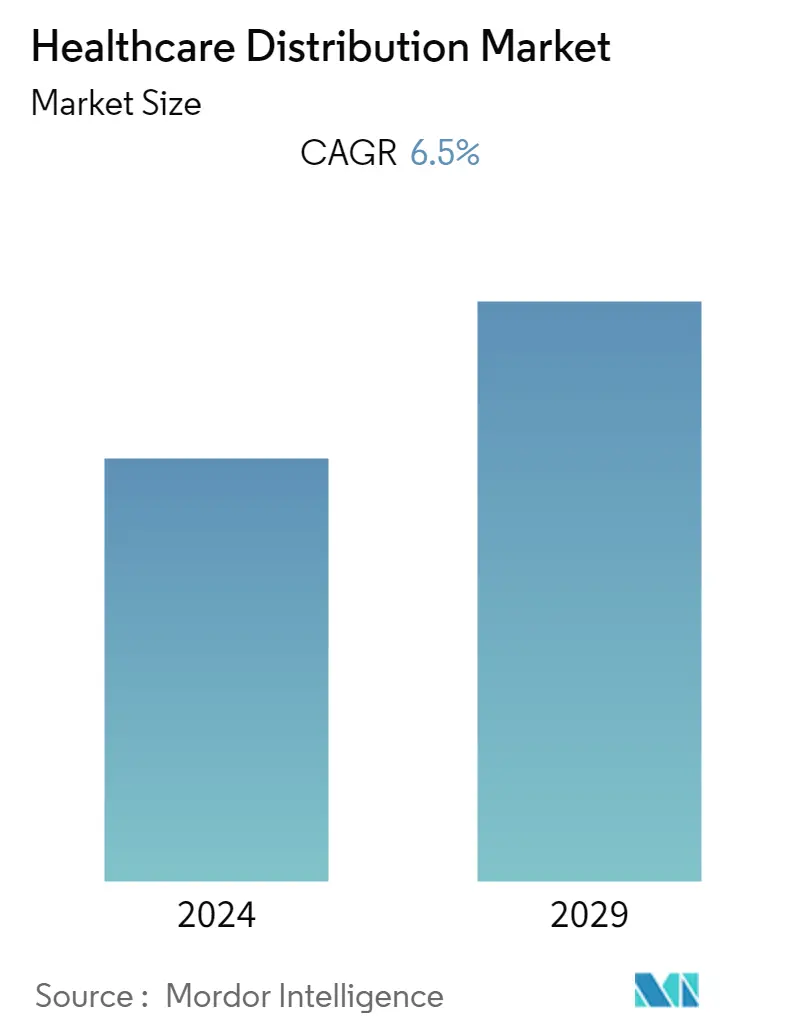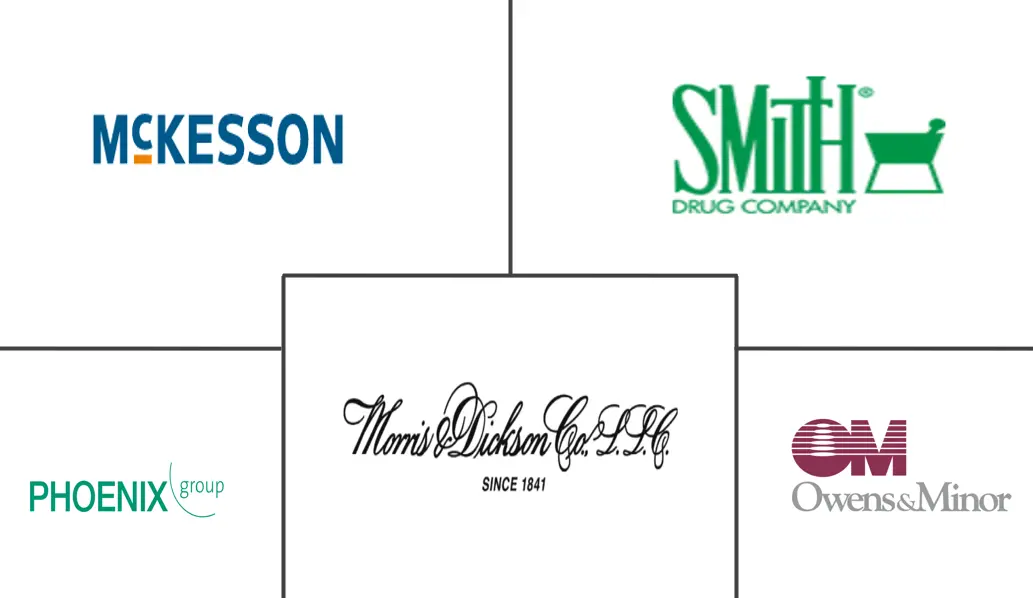Market Size of Healthcare Distribution Industry

| Study Period | 2019 - 2029 |
| Base Year For Estimation | 2023 |
| CAGR | 6.50 % |
| Fastest Growing Market | Asia-Pacific |
| Largest Market | North America |
| Market Concentration | Medium |
Major Players
*Disclaimer: Major Players sorted in no particular order |
Healthcare Distribution Market Analysis
The healthcare distribution market is expected to register a CAGR of 6.5 % over the forecast period.
The COVID-19 pandemic was an incomparable global public health emergency. It impacted almost every industry sector, including healthcare distribution, mainly due to disruptions to the healthcare supply chain. However, the companies took various actions to manage these disruptions in the supply chain through their strategic partners and manufacturer suppliers. For instance, as per the report published by Cardinal Health in December 2021, the company worked closely with its manufacturer suppliers to help ensure a healthy supply of products. In addition, as per the same source, the company installed a new warehouse management system in many distribution centers to manage the challenges in the healthcare supply chain. As a result, the market originally had a modest negative impact but is anticipated to develop due to corporate strategies for addressing supply chain difficulties over the coming years.
With the large economic burden of chronic diseases, technological advancement in distribution, favorable R&D investment scenario, and subsequent increase in drug launches are the main driving factors of the healthcare distribution market. For instance, in 2022, the National Institution of Chronic Disease and Data reported that nearly 60% of American adults suffer from at least one chronic disease, and about 40% of adults include multiple chronic conditions (MCC). Chronic conditions like diabetes, cancer, and cardiovascular disease are the leading causes of morbidity in the United States. Hence, proper management and diagnosis of these diseases are needed with various healthcare products necessary for effective healthcare distribution services. Thus, increasing cases of chronic disease are driving the healthcare distribution market.
Technological advancements and new distribution strategies of market players are expected to boost the healthcare distribution market. For instance, in May 2022, Nippon Express Co., Ltd. launched a logistics service capable of handling goods requiring ultra-low temperatures (-20 C to -85 C) for the pharmaceutical industry. With this, the company provided a pharmaceutical distribution platform with strict temperatures. Hence, these new platforms in healthcare distribution are expected to hold significant growth in the market over the forecast period.
However, the high cost and investment associated with healthcare distribution services are expected to hamper the overall growth of this market.
Healthcare Distribution Industry Segmentation
As per the scope of the market, healthcare distribution refers to entire distribution practices in the healthcare sector used for enterprise resource planning, customer relationship management, medical and pharmacy supplies, wholesaling medications, and distribution and associated services. The healthcare distribution market is segmented by product type (pharmaceutical product distribution services (over-the-counter drugs, generic drugs, and branded drugs), biopharmaceutical product distribution services (recombinant proteins, monoclonal antibodies, and vaccines), and medical devices distribution services), end-user (retail pharmacies, hospital pharmacies, and other end-users), and geography (North America, Europe, Asia-Pacific, Middle East and Africa, and South America). The report also covers the estimated market sizes and trends for 17 countries across major regions globally. The report offers the value (in USD) for the above segments.
| By Product Type | |||||
| |||||
| |||||
| Medical Devices Distribution Services |
| By End-User | |
| Retail Pharmacies | |
| Hospital Pharmacies | |
| Other End-Users |
| Geography | ||||||||
| ||||||||
| ||||||||
| ||||||||
| ||||||||
|
Healthcare Distribution Market Size Summary
The healthcare distribution market is poised for significant growth, driven by technological advancements, strategic partnerships, and the increasing prevalence of chronic diseases. The market experienced initial setbacks due to the COVID-19 pandemic, which disrupted supply chains globally. However, companies like Cardinal Health adapted by enhancing their supply chain management systems and collaborating closely with manufacturers to ensure product availability. The rising economic burden of chronic diseases, coupled with favorable research and development investments, is propelling the demand for effective healthcare distribution services. Innovations in distribution technologies, such as ultra-low temperature logistics by Nippon Express, are expected to further stimulate market expansion.
North America is anticipated to maintain a substantial market share, supported by the rapid growth of the pharmaceutical and biopharmaceutical sectors, alongside the adoption of advanced technologies like artificial intelligence and blockchain. The region's high prescription rates and new distribution agreements, such as those by McKesson Corporation and Endonovo Therapeutics, are expected to drive market growth. The fragmented nature of the market, with key players like McKesson Corporation, Cardinal Health, and others, highlights the competitive landscape. Strategic partnerships and technological integrations are crucial for enhancing distribution efficiency and meeting the increasing demand for healthcare products.
Healthcare Distribution Market Size - Table of Contents
-
1. MARKET DYNAMICS
-
1.1 Market Overview
-
1.2 Market Drivers
-
1.2.1 High Incidence and Large Economic Burden of Chronic Diseases
-
1.2.2 Technological Advancement in Distribution
-
1.2.3 Favorable R&D Investment Scenario, and Subsequent Increase in Drug Launches
-
-
1.3 Market Restraints
-
1.3.1 High Cost of Healthcare Distribution
-
-
1.4 Porter's Five Forces Analysis
-
1.4.1 Bargaining Power of Suppliers
-
1.4.2 Bargaining Power of Buyers/Consumers
-
1.4.3 Threat of New Entrants
-
1.4.4 Threat of Substitute Products
-
1.4.5 Intensity of Competitive Rivalry
-
-
-
2. MARKET SEGMENTATION (Market Size by Value - USD)
-
2.1 By Product Type
-
2.1.1 Pharmaceutical Product Distribution Services
-
2.1.1.1 Over The Counter Drugs
-
2.1.1.2 Generic Drugs
-
2.1.1.3 Branded Drugs
-
-
2.1.2 Biopharmaceutical Product Distribution Service
-
2.1.2.1 Recombinant Proteins
-
2.1.2.2 Monoclonal Antibodies
-
2.1.2.3 Vaccines
-
-
2.1.3 Medical Devices Distribution Services
-
-
2.2 By End-User
-
2.2.1 Retail Pharmacies
-
2.2.2 Hospital Pharmacies
-
2.2.3 Other End-Users
-
-
2.3 Geography
-
2.3.1 North America
-
2.3.1.1 United States
-
2.3.1.2 Canada
-
2.3.1.3 Mexico
-
-
2.3.2 Europe
-
2.3.2.1 Germany
-
2.3.2.2 United Kingdom
-
2.3.2.3 France
-
2.3.2.4 Italy
-
2.3.2.5 Spain
-
2.3.2.6 Rest of Europe
-
-
2.3.3 Asia-Pacific
-
2.3.3.1 China
-
2.3.3.2 Japan
-
2.3.3.3 India
-
2.3.3.4 Australia
-
2.3.3.5 South Korea
-
2.3.3.6 Rest of Asia-Pacific
-
-
2.3.4 Middle East and Africa
-
2.3.4.1 GCC
-
2.3.4.2 South Africa
-
2.3.4.3 Rest of Middle East and Africa
-
-
2.3.5 South America
-
2.3.5.1 Brazil
-
2.3.5.2 Argentina
-
2.3.5.3 Rest of South America
-
-
-
Healthcare Distribution Market Size FAQs
What is the current Global Healthcare Distribution Market size?
The Global Healthcare Distribution Market is projected to register a CAGR of 6.5% during the forecast period (2024-2029)
Who are the key players in Global Healthcare Distribution Market?
McKesson Corporation, Smith Drug Company, Morris and Dickson Company, Owens and Minor Inc and PHOENIX Group are the major companies operating in the Global Healthcare Distribution Market.

